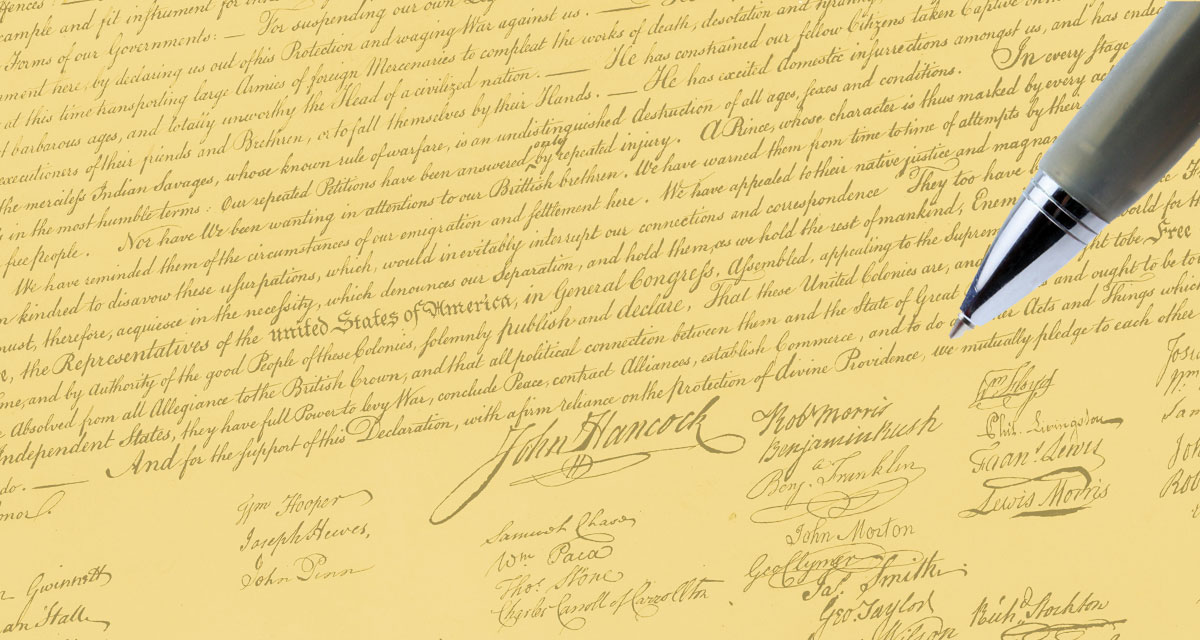When America was in its infancy, good handwriting was so highly esteemed that penmanship experts were sought to hand-copy important documents such as the Constitution and the Declaration of Independence. Today, we still refer to one’s signature as their “John Hancock,” a nod to the bold, iconic signature of this first signer of the Declaration of Independence.
From colonial times until the mid-1900s, cursive writing was an essential part of every school’s curriculum. However, with the invention of the typewriter, the importance of handwriting began to decline. Today, fewer and fewer American schools are even teaching cursive writing, opting instead to emphasize keyboarding skills. It’s easy to understand why: it’s impossible to send a text, compose an e-mail, or log on to a website if you don’t know your way around a keyboard. Unfortunately, this very legitimate need to master the keyboard has all but eclipsed the skill of cursive writing. While swapping keyboards for pens may be a sign of progress, it may not be as smart a tradeoff as it seems. Cursive writing benefits cognitive and academic skills in ways that keyboarding simply cannot.
Here are five reasons why the pen is—and always will be—mightier than the keyboard:
- Learning how to write by hand makes one “cursive literate.”Those who never learn cursive handwriting have trouble reading it. Iris Hatfield, the author of New American Cursive, notes, “When individuals cannot read cursive, they are cursively illiterate in their own language.” Thus, people who cannot decipher cursive writing may find themselves at a disadvantage in certain circumstances.
- Cursive writing develops fine motor skills.Younger students need the neurosensory experience that handwriting provides. That is, they need to feel the pen in their hand and they need to feel the paper. They must learn how much pressure to exert upon the pen and how to position the paper to best accommodate their writing. Then they must apply the proper motion needed to form each letter. By contrast, typing requires only repetitive motion. According to Candace Meyer, CEO of “Minds-in-Motion, Inc.,” cursive writing “builds the neural foundation of sensory skills needed for a myriad of everyday tasks such as buttoning, fastening, tying shoes, picking up objects, copying words from blackboards, and most importantly, reading.”
- Taking notes by hand enhances learning. Older students benefit more from taking notes by hand than typing them onto laptops. Why? Consider the difference in the thought processes that occur with typing versus writing. When someone types notes onto a laptop during a lecture, it’s easier to capture the teacher’s words verbatim. The focus is more on keeping up the pace of transcription than on what’s being said. Alternatively, when taking notes by hand, since we cannot write fast enough to capture a speaker’s words verbatim, students are forced to process what is being said and to summarize it in words that make sense to them. Thus, they’re more engaged with the information and more likely to understand it better.
- Handwriting improves spelling. When writing on a computer or tablet, or when texting on a smartphone, it is all-too-easy to become dependent on the software’s spell check and auto-correction features. In fact, kids may hardly notice that the device even corrected their spelling errors. With handwriting, of course, there is no such automatic aid, making it more likely that they will learn to spell the old- fashioned way!
- Cursive writing boosts literacy. According to www.pens.com, the practice of handwriting improves children’s literacy. The explanation is that children who can “quickly translate the mental image of a letter into its physical form on paper have a clearer understanding of how letters form words, sentences, and meaning.”
In 1977, the Writing Instrument Manufacturers Association (WIMA) created National Handwriting Day to remind us all “to re-explore the purity and power of handwriting.” WIMA’s suggestions for observing the day include sending a handwritten note to a friend or paying with a check. WIMA’s choice for National Handwriting Day was, appropriately, John Hancock’s birthday, January 23rd. January is a long way off, so you may want to jot a Handwriting Day reminder on your next year’s calendar right now—in cursive, of course!




















